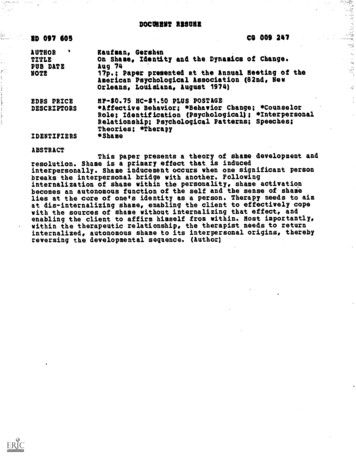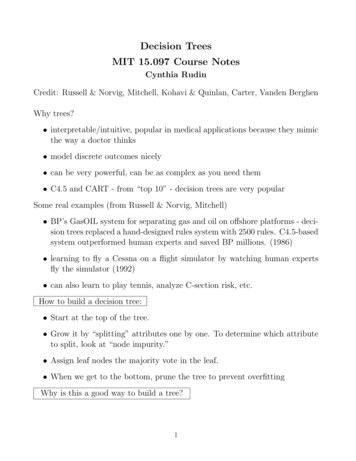
Transcription
DOCUMENT 1I MIED 097 605AUTHORTITLEPUB DATENOTE4EDRS PRICEDESCRIPTORSIDENTIFIERSCO 009 247Kaufman, GershonOn Shame, Identity and the Dynamics of Change.Aug 7417p.; Paper presented at the Annual Meeting of theAmerican Psychological Association (82nd, NewOrleans, Louisiana, August 1974)MF- 0.75 HCS1.50 PLUS POSTAGE*Affective Behavior; *Behavior Change; *CounselorRole; Identification (Psychological); *InterpersonalRelationship; Psychological Patterns; Speeches;Theories; *Therapy*ShameABSTRACTThis paper presents a theory of shame development andresolution. Shame is a primary effect that is inducedinterpersonally. Shame inducement occurs when one significant personbreaks the interpersonal bridge with another. Followinginternalization of shame within the personality, shame activationbecomes an autonomous function of the self and the sense of shamelies at the core of one's identity as a person. Therapy needs to aimat dis-internalizing shame, enabling the client to effectively copewith the sources of shame without internalizing that effect, andenabling the client to affirm himself from within. Most importantly,within the therapeutic relationship, the therapist needs to returninternalized, autonomous shame to its interpersonal origins, therebyreversing the developmental sequence. (Author)
4LIIDEPARTMENT OF REALM.EDUCATION A WELFARENATIONAL INSTITUTE OFEDUCATIONTHIS DOCUMENT HAS BEEN REPRODUPED EXACTLY AS RECEIVED I-ROMTHE. PERSON OR ORGANI/AT ION ORIGINA TING IT PDIN TS Of. VIEW OR OPINIONSSATED DO NOT NECFSSARILY RE PRESENT Oil ICiAL NATIONAL INSTITUTE OFEDUCATION POSITION OR POLICYOn Shame, Identity and the Dynamics of ChanseGershen KaufmanMichigan State UniversityIThough wordshad lived with shame all my life without knowing it as such.come now,Inever had words for shame and never understood its meaning until oneday when Sill Kell related to me how a need that is not responded to appropriatelyThat began for me a process of discoveringconverts to shame and then to rage.the significance of shame, a processIwould like to share with you now.The nature of shame can best be understood by differentiating its basicdimensions.First, shame is a primary affect. Second, shame is induced inter-personally in relation to significant others, originally parents.Third, aftershame becomes internalized, within the personality, shame activation becomes anautonomous function of the self and the sense of shame becomes a core part ofones identity as a person.In order for the therapeutic process to resolveinternalized shame, these dimensions need to be attended to.Shame:The Affect that BindsSome eventAt the level of affect, shame begins as the feeling of exposure.suddenly focuses our attention upon ourselves and our eyes turn inward in painfulscrutiny.We Nel immediately exposed to ourselves and to others and may experiencean urgent need to escape or hide.the self (Tomkins, 1963).The feeling is one of torment or sickness withinBinding self-consciousness deepens along with feelingexposed, creating a paralyzing effect.Since shame is the experience of the selfby the self, we experience ourselves totally as in no other affect.Shame canculminate in feeling alienated, defeated, lacking in dignity or worth.
-2-Shame Inducement: Breaking the Interpersonal BridgeIn my view, shame is inevitable when individuals interact precisely becausewe are human and therefore behave in ways that have unintended impact.Wheneversomeone becomes significant to us, whenever anther's caring matters, shame becomes possible.Relationships evolve out of reciprocal interest and shared ex-periences of trust.An emotional bond begins to grow between individualt asthey communicate understanding, respect and valuing for each other's personhood,needs and feelings included.That bond deepens along with trust and makes possibleexperiences of openness and vulnerability.The bond which ties two individualstogether forms an interpersonal bridge between them.Emotional severing or break-ing of that interpersonal bridge is the primary shame-inducing process (KeIl,1972,1973; Bassos and Kaufman, 1973; Kaufman, in press).When we become significant to another person, as happens when we are therapist,supervisor, friend, spouse, or parent, then we can induce shame in that otherperson, unconsciously, unintentionally, even without knowing it has happened.Fail-ure to fully hear and understand the other's need and communicate its validity,whether or not we choose to gratify that need, can sever the bridge and induceshame.A clientIworked with, Ted, once asked if we could go canoeing together.Instead of responding directly to his requesta need or a want", implying thatIIasked Ted "if going canoeing waswould say yes to a "need" but not to a "want."He thought about it, decided his request was really a "want", and ambivalentlydropped out of therapy.Let us enter Ted's Experience for a moment.Asking Ted to examine his re-quest induced sudden self-consciousness and exposure.The resulting sense ofshame dee)ened as he felt there was something wrong with his need or wrong withhim as a person.Why else would his request not be responded to?The secondary
.3response Ted felt was fear of further exposure and he consequently backed out ofour relationship.WhenIfailed to approach him, Ted felt confirmed in his shame,which became a growing barrier between us since he could not risk exposure of hisbadness.Then, whenIdid make several direct approaches to him, Ted's overtresponse was rage.Rage serves a vital self-protective function by keeping others away andinsulating the self against further exposure and further experiences of shame.Unfortunately, the deep distress or feelings of hurt which may accompany shamealso become encapsulated, hidden from view and inaccessible to therapeutic reFear, rage and distress can be secondary responses to shame. (Tcmkins,lief.1973). The shamer initially is shown only the rage; others may or may not see thedeep hurt and pain resulting from the ruptured relationship.We may fail to respond appropriately to another's need in a great varietyof ways.Simple oversight, lack of sensitivity or even well-intentioned criticismfrom significant others can convey the sense that one is not quite good enough asa person.Occasionally, our response involves disparagement, contempt, humiliationor a direct transfer of blame.Shame experienced under these conditions is far moreintense and is accompanied by deeper rage and possibly longings for revenge.These are all instances of emotional severing between people in an on-going relationship.Since the interpersonal bridge is built upon certain expectations,rests upon learning to expect a certain mutuality of response,having these basicexpectations of others suddenly exposed as wrong is a primary inducer of shame.Shame Internalization:IShame Becomes Autonomoushave discussed some of the ways we have at our disposal to induce shame inone another.The fact that shame is the experience of the self by the self, that
-4-shame becomes a barrier to intimacy, and that shame Is alienating and isolatingare not sufficient to explain the significance of shame as a central motive inhuman development and interpersonal relations.The developmental theory of shameis based on the additional concept of internalization. After shame has becomeinternalized within the personality as a major source of one's identity, the selfbecomes able to both activate and experience shame without an inducing interpersonal event.The self is then susceptible to shame irrespective of the externalmessages, good or had, being communicated from others.In effect, shame becomesautonomous when internalized and hence, impervious to change.Shame internalization is a development that is both gradual and complex.least three distinct processes interact in leading to that outcome.AtFirst,periods.of emotional pain increase susceptibility to internalization by making theself uniquely vulnerable.Both the external verbal messages communicated andother affects induced in the individual during moments of deep pain can becomeinternalized as core affect-beliefs which help shape our sense of identity.second process involves identification with the shaming parent.AAs Tomkins (1963)has argued, no wish of the child's is stronger than to be like the beloved parent.Modeling is one primary vehicle for such identification.We internalize not onlywhat is said about us but especially the very ways in which we are treated bysignificant others, and we learn to treat ourselves accordingly.The third way in which internalization is hypothesized to occur involves thedevelopment of specific affect-shame (Tomkins,1963) and need-shame binds withinthe personality.Whenever the expression of a particular affect, such as anger,crying in distress, or fear, is followed by a parental response which induces shame,an internalized affect-shame bind results.later expression of that affect.This affect-shame bind then controlsFor example, a child who isshamed for being afraidwill learn that there is something wrong with him whenever he feels fear.
-5-Situations which then arouse anxiety will autonomously activate shame, therebybinding that affect.Thus, a particular affect can now spontaneously activateshame without shame being directly induced.powerful indirect control over behavior.This enables shame to exercise aWhen all affects meet with shaming, atotal affect-shame bind results, which only hastens the realization that one isshameful as a person.Need-shame binds arise in an analogous manner.Learning to integrate one'sbasic needs is a developmental task which can be disrupted.Disturbances inintimacy, autonomy, sexuality, or dependency, to name a few, can result from eitherFor example, sustained eye contact isdirect or inadvertent shame inducement.a most intense form of interpersonal intimacy according to Tomkins (1963).Mutuallooking very early becomes bound by shame when the child is shamed both for lookingtoo directly into the eyes of a stranger and for being shy in the presence of estranger.The need for human touching also is fundamental (Montagu, 1972).Physical holding is the child's natural request in response to emotional need ordistress, however precipitated.Although holding can communicate security, re-store trust, and re-affirm one's own well-being, all too frequently that need becomes bound and controlled by shame.Internalization of shame means that the affect of shame is no longer merelyone affect or feeling among many, which become activated and pass on.Rather,internalized shame is experienced as a deep sense of being defective and neverquite good enough as a person.This affect-belief lies at the core of the selfand gradually recedes from consciousness.one's identity.In this way, shame becomes basic toWhile the underlying affect is the same, the conscious experienceof internalized shame differs widely.For example, feelings of inadequacy, re-jection or self-doubt,faeling guilt-ridden or unloveable as a person,and pervasiveloneliness are all conscious or semi-conscious expressions of internalized shame.
Internalization also means that the self can now autonomously activate andexperience shame in isolation.Conscious awareness of limitations, failures, orsimply awareness of not achieving a prescribed goal can activate paralyzing shame.There need not even be any external precipitating event.One client who feltterribly ambivalent about ending his marriage experienced acute shame when heThat occasion forced himapproached a clerk to ask for a divorce application.to expose his failure which activated his internalized sense of shame.The varieties and depth of shame, a shameful identity in the form of anunderlying sense of defectiveness,and autonomous shame activation by the selfThere is a fourth con-are consequences which stem from shame internalization.sequence, one which ensures that these three continue to reinforce one another sothat shame becomes solidified within the personality.sequence the internal shame spiral.Ihave termed this con-A triggering event occurs.trying to get close to someone and being rebuffed.Perhaps it IsThe event could be either acritical remark from a friend or being blamed for something.It could even besimply not having anyone approach for several days or not being sought after orinvited out.Either the event is in actuality shame-inducing (involving a currentsignificant other breaking the interpersonal' bridge) or the event autonomouslyactivates shame.eyesEither way, "When a person suddenly is enmeshed in shame, theturn inward and the experience becomes totally internal, frequently withvisual imagery present.The shame feelings and thoughts flow in a circle, endlesslytriggering each other off.The precipitating event is relived internally over andover, causing the sense of shame to deepen, to absorb other neutral experiencesthat happened before as well as those that come later, until finally the self isengulfed.In this way, shame becomes paralyzing" (Kaufman, in press).This internalshame spiral is experienced phenomenologically as "tail-spinning", "spiralingdownwards" or "snowballing."Each occurrence of the shame spiral can go on toinclude a reliving of previous shame precipitating events which'thereby solidifies
-7-shame further within the personality and spreads shame to many different people,events, situations, and behaviors.Shame does not necessarily remain a conscious process.When shame does re-main conscious, the sequence of events can happ'n so rapidly that clear recognitiono' those events by self or others is hindered.Gradually, defensive strategiesevolve to enable the self to escape from and avoid paralyzing shame, particularlyif intense exposure fears also develop.Fear of exposure, one of the secondary responses to shame, isoriginallylemled whenthe child's natural attempts to re-affirm the ruptured parental relationship areshamed again, however inadvertently.Exposure fear then operates to furtherencapsulate shame, hide it from view, and finally mask shame from consciousness.Frequently only the fear remains conscious.self takes on a more devastating meaning.basic defectiveness as a human being.unspeakably bad.After internalization, exposure it-Exposure now meals exposure of one'sTo be seen is to be seen as irreparably andShame experiences become paralyzing partly because exposure it-self eradicates the words.One feels speechless, trapped, helpless and utterlyalone, though feelings of rage and omnipotence may soon follow.After shame becomesinternalized a new shame experience, whether induced or activated autonomously,must be defended against, compensated for, or transferred interpersonally becauseexposure to others and to oneself has become intolerable.Resolution of internalized Shame: The Restoring ProcessAs long as shame remainvented.internalized and autonomous, real change is pre-New experiences with others, however positive, fail to alter one's basicsense of self unless the developmental sequence also is reversed.Such a re-versal process is slow and painful, because intense fear of exposure and strategiesof defense prevent access by the self or others to that most vulnerable core of the
-8self.Within the therapeutic relationship, internalized shame needs to be returnedto its interpersonal origins.The self that feels irreparably and unspeakablydefective needs to feel restored with the rest of humanity.The self that feelsalienated, defeated, lacking in dignity or worth needs to feel whole, worthwhileand valued from within.if shame originates from an interpersonal severingresolution must involve a restoring process.process,If internalization develops fromidentl"ication, from need-shame and affect-shame binds, and from periods of deepemotional pain which increase susceptibility to internalization, then dis-internalization must involve the offering of a new identification model, the dissolutionof affect-shame and need-shame binds, and an experiencing of the emotional painassociated with defectiveness within the therapeutic process itself, provided thatnew affect-beliefs about the self can also become internalized.At the outset of therapy, internalized shame is rarely assessible to consciousness.Those manifestations which are conscious are uniquely varied.Feelinginadequate or irferior, worthlessness and fears of rejeczion are some examples.One client always believed he was a stupid person.failure interpersonally.Another client feels like aAnother feels angry at the whole world.Another has with-drawn himself into a cocoon of loneliness and defiantly refuses to come out. Distress and pain may not even be evident, since defensive strategies, such asstriving for perfection, rage, contempt for others, striving for power, or internalwithdrawal (Tomkins, 1963; Kaufman, in press), can so totally mask shame from view.The therapeutic process, as Kell and Burow (1970)have described it, consistsof the living out of a corrective emotional experience.comes significant in that endeavor.to shame is whatIClearly, the therapist be-How that living out needs to occur in relationwould like to make especially clear.The therapeutic processesnecessary for the resolution of internalized shame can be most clearly understoodby differentiating them one from another.
-9-Interpersonal Bridging.one of course.We begin with building a bridge, an interpersonalThe building of trust within the therapeutic relationship isslow and painstaking, since the original failures were early and deep ones.Building the interpersonal bridge gradually lessens the need for defensive strategiesand makes possible experiences of vulnerability and openness between therapist andclient, as Kell and eurow (1970) have observed.Mutual understanding, growth andchange are thereby facilitated.Once built, such a bridge needs to be maintained in a particular fashion inrelation to shame.Let me clarify.Bridging thus becomes an on-going process.Shame feelings need to be actively approached and openly validated by the therapist.When this n:curs, exposure fears become reduced, thereby enabling the client's awareness of his internal shame processes to deepen even further.In effect, theclient learns an important interpersonal lesson, namely, that expression of shamewill not be shamed again.Therapist approach and validation need to follow eachtime the client dips deeper into shame.Otherwise, the client will feel abandoned,shamed again or experience his shame as too threatening for the therapist.The dipfor several clients of mine has gone so far as to involve intense fears of "goingcrazy."Ihave had to sit on my own anxiety and go with them into their inner ex-perience in order for them to begin to feel restored.Thus, interpersonal bridgingis the first basic, on-going process of the therapeutic endeavor, and both underliesand facilitates the remaining therapeutic processes.Discovering the Original Sources of Internalized Shame.As the client's ownawareness of shame gradually deepens through the bridging process, therapist andclient increasingly are able to discover the original inducing events within thefamily.Our sense of worth and adequacy as human beings rests upon having certainfundamental needs responded to positively as we grow, thereby enabling us to feelsecure in our personhood.Frequently, though certainly not always, shame internal-ization follows from parental rejection of the child's most fundamental needs, how-
-Never unconscious that rejection may be.Such rejection may occur, for example,when one or both parents did not want the child at all or really wanted a child ofthe opposite sex.Shame can also be rooted in a parent looking to the child to makeup for the parent's deficiencies, in looking to the child to literally be parent tothe parent, or in wanting the child never to need anything emotionally from the parent-7in a sense, to have been born an adult.(I am indebted to Dr. Sue Jennings, 1972, forthe latter idea.) Or the child may simply have been born the wrong tivverament for thesex; quiet, more introverted boys and outgoing, aggressive girls have traditionallyfared less well in our culture because they fail to match the expectations of significant others.Rejection may be clear and open, ambivalent and hidden, or defendedagainst by over-possessiveness and over - protectiveness.Finally, parental behaviorcan have unintendedrejecting impact upon the child, through communicating failure tomeet parental expectations, even when parental attitudes are not inherently rejecting.Expanding awareness of and discovering the original sources of internalizedshame, in conjunction with experiencing the emotional pain associated with defectiveness, together make possible the internalization of new affect-beliefs about the self.The developing new relationship with the therapist gradually enables the client torelinquish some of hiold, shameful identity.And a new sense of identity tentativelybegins to emerge.Dissolution of Specific Affect-Shame and Need-Shame Binds.In these cases, re-jection has been partial and specific to particular affects, behaviors or needs,whether that rejection was intentional or inadvertent.Affect-shame and need-shamebinds need to be dissolved by making both the bind and its source conscious for theclient.The need or affect itself also needs to be validated.This can happen by en-couraging the client through new, perhaps frightening experiences outside of therapythat are themselves corrective.This also happens through living out corrective ex-periences within the therapeutic relationship.For instance, a client deeplyashamed of needing to be held may eventually ask to be held by the therapist.
-11-Most frequently, such emotionally corrective occurrences are an on-goingtoftenunnoticed, part of the therapeutic process.attialauslosthe Link Between Shame and Strate ies of Defense.against shame are adaptive.intolerable shame.DefensesThey have been the client's only ways of survivingStrategies of defense aim at protecting the self againstfurther exposure and further experiences of shame.Several of the most prominentstrategies are rage, contempt for others, the striving for perfection, the strivingfor power, and internal withdrawal (Tomkins, 1963; Kaufman, in press).Bothperfectionism and power-seeking are strivings against shame and attempt to compensatefor the sense of defectiveness which underlies internalized shame.are unitary strategies;None of theserather, they become expressed in unique and varied ways,with several often functioning together.The therapeutic aim is not to eliminatethose strategies but to enable the client to learn new, more adaptive ways ofcoping with the sources of shame.Gradually, the need for rigid defensive strategieslessens as their meaning in relation to shame becomes clearer to the client.Asthe client's tolerance for shame thereby increases, the powerful need to transferinterpersonally experienced shame also lessens.Enabling the Client to Learn to Cope Effectively With the Sources of ShameWithout internalizing that Affect.Whenever a client expresses bad feelings aboutself, the therapist needs to attend not only to those feelings but to the source ofthosefeelings as well (a differentiation also emphasized by Tomkins,1963).If the source of bad feelirgs is the self's autonomous activation of shame followingsome past or current precipitating event, the therapist needs to enable the client tolearn how to cope effectively with the sources of shame without internalizing thataffect.There are many ways in which this occurs during the course of therapy.way concerns the appropriate handling of the client's shame spirals.OneThe therapistneeds to enable the client to learn to recognize, intervene consciously and
-12-terminate that internal shame spiral.Attempts at understanding the experiencewhile it is spiraling or snowballing only embroil one deeper into shame.Deliberatelyfocusing all of one's attention outside oneself by becoming visually involved inthe world breaks the shame spiral and allows those feelings and thoughts tosubside.Later, the precipitating cause can be explored and understood with oneaim being, enabling the client to intervene even sooner in the future.Thetherapist can both intervene directly when shameis spiraling within the session,and enable the client to do likewise on his own.The client thereby gains activeIn effect, the therapist helpscontrol over his internalized shame processes.the client know not only which bad feelings he needs to feel and which to let goof, but especially, how not to internalize them.Equally basic to therapy, the therapist needs to provide the client with newways of understanding his own experiencn which then enable him to free himself fromthe paralyzing effects of shame.in life.Defeats, failures and rejections are inevitableWe need to learn how not to internalize the feelings of shame whichnaturally arise, while still being able to profit and learn from the very "mistakes"which may have contributed to these failures in the first place.did this was through the concept of "learning time."One way Bill KellWe need time to both makemistakes and live them out, without internalizing those mistakes as personal failures,precisely in order to gain eventual mastery.The therapist provides a very important,new identification model in this regard.A client, Ron,was deeply troubled about intimacy.He believed that he wasdefective in not being able ever to sustain an intimate relationship.One session,Ron came in expressing much hurt and pain because the group living situation hehad been heavily invested in was falling apart, due to one of the other member'sconflicts.He began selhing about this being a repeat of his other failures.listened to his feelings o' shame butdifferent.IIalso pointed out to him that tnis time wasRon looked at me quizzically.Iclarified for him that this time
-13-he had stayed in the relationship long enough to learn that it was not his personalfailure which was causing the problem.His tears dri.A up, he sat up in his chairand Said "I'm done for today."The sources of shame are rot always externally based.They can be internal inMost frequently,the form of the self's own awareness of perceived limitations.we have learned to feel ashamed of those aspects of self which make us feeldifferent from others.The therapist needs to enable the client to accept,perhapseven to find value in, those very aspects of himself which he finds most intolerable.Only then can change begin to occur.Shame Inducement and Resolution Within the Therapeutic Relationship.If thesource of shame lies within the therapeutic relationship, the therapist needs torecognize, hear and validate those feelings, even acknowledging his own partinWhen the therapist becomes significant to the client and theproducing them.therapist's caring, respect and valuing begin to matter, the therapist himselfbecomes a potential inducer of shame.When he has induced shame within the client,however inadvertently, the therapist can restore the interpersonal bridge heif the therapist,severed by openly acknowledging his own part in that process.someone deeply valued, can acknowledge his imperfect humanness, even his part inmaking us feel shame, those shame feelings pass on.The growth impact is fargreater than if the severing experience had never happened in the first place.When inducing shame is followed by restoring the bridge, internalization does notoccur.With one client, Martha,Ihad no idea anything was wrong untilIreceived aletter from her expressing her intention to stop therapy though feeling much hurt,pain and rage.Icalled her and she decided to come in.ifIreally cared aboutWe began fine butIgradually became a-feel better about working with me, though still wonderingher.The very next session was critical.Somehow she began to
-I4-ware that something was wrong again.Then Martha began talking of terminating.What emerged, as we tried to understand the sequence, was that wheneverIlookedout of the winc;ow, Martha felt abandoned and rapidly withdrew inside herself.Shame and rage followed.the window butsomehow whatIIIacknowledged my part, that is,did not intend to abandon her.IIdo like to look outpersisted in suggesting thathad done must also have happened before.Martha came in the follow-ing session having remembered similar occurrences with her step-father during childhood.Developing the Client's Capacity to Affirm Himself From Within.The foregoing-therapeutic processes interact with one another, gradually enabling the client todis-internalize shame, to learn to cope effectively with those potential sources ofshame to which he is uniquely vulnerable, and to begin to affirm himself from within.The capacity to affirm oneself and the evolving of a separate identity are mutuallyenhancing.Self-affirmation is facilitated by therapist valuing of the client'suniqueness as a person, by enabling the client to tolerate shame feelings, andby enabling the client to learn to cope with the sources of shame without internalizing that affect.Of necessity, self-affirmation continues after separation fromthe therapist, which usually involves termination of therapy but not necessarilytermination of the relationship.Realization of the self-affirming capacity integrates the self around a newcore.The self gradually becorres a primary source of its own caring, respect andvaluing, as it begins to recognize and value both our human communalities and thosevery things which make us uniquely different.Because the self can now continuefeeling affirmed from within even in the face of defeat, failure or rejection, shamecan remain a feeling which is activated or induced and then passes on.remain susceptible to shame.We alwaysWhile the self continues being able to experienceshame, it has begun to learn how not to internalize that affect.have learned how to restore the bridge with ourselves.In effect, we
-15-Shame Development and Resolution:The Proces
Shame Inducement: Breaking the Interpersonal Bridge. In my view, shame is inevitable when individuals interact precisely because we are human and therefore behave in ways that have unintended. impact. Whenever. someone becomes significant to us, whenever anther's










